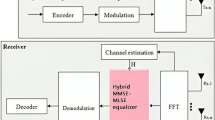Abstract
Considering the cost and power consumption problems of the high-speed wireless communication receiver for high-precision quantization, this paper discusses the time-domain channel estimation for MIMO-OFDM systems with low-precision quantization. The low-precision quantization affects the performance of the system, however, by selecting the appropriate training sequence information, introducing the feedback dither control signal and using the optimized channel estimation algorithm, even with such low-precision (e.g., 1–3 bits) quantization, also can be obtained the performance of comparable the full precision MMSE criterion. Thereby reducing the complexity of the subsequent signal processing, cutting down the cost and power consumption, and effectively reducing the effect of low-precision quantization on the system performance. Theoretical analysis and simulation results show that this method has the characteristics of the fast convergence rate, higher estimation accuracy. Implement the receiver of the low cost, low power consumption and higher transmission efficiency of the system.





Similar content being viewed by others
References
Walden, R. (1999). Analog-to-digital converter survey and analysis. IEEE Journal on Selected Areas in Communications, 17(4), 539–550.
Lundbery, K. H. (2002). High-speed analog-to-digital converter survey. http://web.mit.edu/klund/www/papers/UNP_flash.pdf. Accessed 20 June 2013.
Le, Bin, Rondeau, Thomas W., Reed, Jeffrey H., & Bostian, Charles W. (2005). Analog-to-digital converters. IEEE Signal Processing Magazine, 22(6), 69–77.
J. Singh, O. Dabeer, U. Madhow. (2007). Communication limits with low precision analog-to-digital conversion at the receiver. In 2007 IEEE international conference on communications (pp. 6269–6274). Glasgow.
Singh, J., Dabeer, O., & Madhow, U. (2008). Transceiver design with low-precision analog-to-digital conversion: An information-theoretic perspective. Mathematics, 2008, 1–32.
Singh, J., & Madhow, U. (2009). On block noncoherent communication with low-precision phase quantization at the receiver. In IEEE International conference on symposium on information theory (Vol. 2009, pp. 2199–2203). IEEE Press.
Singh, J., Dabeer, O., & Madhow, U. (2008). Capacity of the discrete-time AWGN channel under output quantization. Mathematics, 2008, 1218–1222.
Dabeer, O., Singh, J., & Upamanyu, M. (2006). On the limits of communication performance with one-bit analog-to-digital conversion. In IEEE, workshop on signal processing advances in wireless communications, 2006 (pp. 1–5). Spawc ‘06.
Sampath, H., Talwar, S., Tellado, J., et al. (2002). A fourth-generation MIMO-OFDM broadband wireless system: design, performance, and field trial results. IEEE Communications Magazine, 40(9), 143–149.
Ping, Z. H. A. N. G. (2002). Some research issues for beyond 3G mobile systems. Journal of Beijing University of Posts and Telecommunications, 25(3), 1–6.
Li, M. Q., Tan, J. G., & Zhang, W. J. (2004). A channel estimation method based on frequency-domain pilots and time-domain processing for OFDM systems. IEEE Transactions on Consumer Electronics, 50(4), 1049–1057.
Song, B. W., Gui, L., & Zhang, W. J. (2006). Comb type pilot aided channel estimation in OFDM systems with transmit diversity. IEEE Transactions on Broadcasting, 52(1), 50–57.
Singh, J., Ponnuru, S., & Madhow, U. (2009). Multi-Gigabit communication: the ADC bottleneck. IEEE International Conference on Ultra-Wideband, 2009, 22–27.
Lin, Z., Peng, X., & Chin, F. (2011). Joint carrier frequency offset and channel estimation for OFDM based Gigabit wireless communication system with low precision ADC. In Vehicular Technology Conference (VTC Fall) (pp. 1–5). IEEE.
Dabeer, O., & Madhow, U. (2010). Channel estimation with low-precision analog-to-digital conversion. In Proceedings of the IEEE international conference on communications (pp. 23–27).
Schuchman, L. (1964). Dither signals and their effect on quantization noise. IEEE Transactions on Communication Technology, 12(4), 162–165.
Zeitler, Georg, Kramer, Gerhard, & Singer, Andrew C. (2012). Bayesian parameter estimation using single-bit dithered quantization. IEEE Transaction on Signal Processing, 60(6), 2713–2726.
Melkonian, L. (1992). Improving A/D converter performance using dither. National Semiconductor Corporation, Application Note 804, USA.
Acknowledgments
This work is fully supported by and the Innovation Group Build Plan for the Universities in Sichuan [No. 13TD0017, No. 2015TD0022), Science Founding of Artificial Intelligence of Key Laboratory of Sichuan Province [No. 2012RYJ05], and the Talents Project of Sichuan University of Science and Engineering (No. 2014RC13).
Author information
Authors and Affiliations
Corresponding author
Rights and permissions
About this article
Cite this article
Xiong, X., Wang, H. A Time-Domain Channel Estimation Method for MIMO-OFDM Systems with Low-Precision Quantization. Wireless Pers Commun 94, 1869–1879 (2017). https://doi.org/10.1007/s11277-016-3716-8
Published:
Issue Date:
DOI: https://doi.org/10.1007/s11277-016-3716-8




